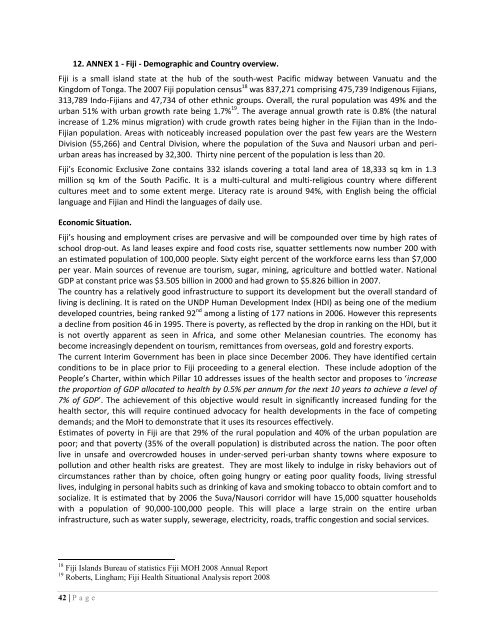Project Report â Fiji 2010 - Pacific Health Voices
Project Report â Fiji 2010 - Pacific Health Voices
Project Report â Fiji 2010 - Pacific Health Voices
You also want an ePaper? Increase the reach of your titles
YUMPU automatically turns print PDFs into web optimized ePapers that Google loves.
12. ANNEX 1 - <strong>Fiji</strong> - Demographic and Country overview.<br />
<strong>Fiji</strong> is a small island state at the hub of the south-west <strong>Pacific</strong> midway between Vanuatu and the<br />
Kingdom of Tonga. The 2007 <strong>Fiji</strong> population census 18 was 837,271 comprising 475,739 Indigenous <strong>Fiji</strong>ans,<br />
313,789 Indo-<strong>Fiji</strong>ans and 47,734 of other ethnic groups. Overall, the rural population was 49% and the<br />
urban 51% with urban growth rate being 1.7% 19 . The average annual growth rate is 0.8% (the natural<br />
increase of 1.2% minus migration) with crude growth rates being higher in the <strong>Fiji</strong>an than in the Indo-<br />
<strong>Fiji</strong>an population. Areas with noticeably increased population over the past few years are the Western<br />
Division (55,266) and Central Division, where the population of the Suva and Nausori urban and periurban<br />
areas has increased by 32,300. Thirty nine percent of the population is less than 20.<br />
<strong>Fiji</strong>’s Economic Exclusive Zone contains 332 islands covering a total land area of 18,333 sq km in 1.3<br />
million sq km of the South <strong>Pacific</strong>. It is a multi-cultural and multi-religious country where different<br />
cultures meet and to some extent merge. Literacy rate is around 94%, with English being the official<br />
language and <strong>Fiji</strong>an and Hindi the languages of daily use.<br />
Economic Situation.<br />
<strong>Fiji</strong>’s housing and employment crises are pervasive and will be compounded over time by high rates of<br />
school drop-out. As land leases expire and food costs rise, squatter settlements now number 200 with<br />
an estimated population of 100,000 people. Sixty eight percent of the workforce earns less than $7,000<br />
per year. Main sources of revenue are tourism, sugar, mining, agriculture and bottled water. National<br />
GDP at constant price was $3.505 billion in 2000 and had grown to $5.826 billion in 2007.<br />
The country has a relatively good infrastructure to support its development but the overall standard of<br />
living is declining. It is rated on the UNDP Human Development Index (HDI) as being one of the medium<br />
developed countries, being ranked 92 nd among a listing of 177 nations in 2006. However this represents<br />
a decline from position 46 in 1995. There is poverty, as reflected by the drop in ranking on the HDI, but it<br />
is not overtly apparent as seen in Africa, and some other Melanesian countries. The economy has<br />
become increasingly dependent on tourism, remittances from overseas, gold and forestry exports.<br />
The current Interim Government has been in place since December 2006. They have identified certain<br />
conditions to be in place prior to <strong>Fiji</strong> proceeding to a general election. These include adoption of the<br />
People’s Charter, within which Pillar 10 addresses issues of the health sector and proposes to ‘increase<br />
the proportion of GDP allocated to health by 0.5% per annum for the next 10 years to achieve a level of<br />
7% of GDP’. The achievement of this objective would result in significantly increased funding for the<br />
health sector, this will require continued advocacy for health developments in the face of competing<br />
demands; and the MoH to demonstrate that it uses its resources effectively.<br />
Estimates of poverty in <strong>Fiji</strong> are that 29% of the rural population and 40% of the urban population are<br />
poor; and that poverty (35% of the overall population) is distributed across the nation. The poor often<br />
live in unsafe and overcrowded houses in under-served peri-urban shanty towns where exposure to<br />
pollution and other health risks are greatest. They are most likely to indulge in risky behaviors out of<br />
circumstances rather than by choice, often going hungry or eating poor quality foods, living stressful<br />
lives, indulging in personal habits such as drinking of kava and smoking tobacco to obtain comfort and to<br />
socialize. It is estimated that by 2006 the Suva/Nausori corridor will have 15,000 squatter households<br />
with a population of 90,000-100,000 people. This will place a large strain on the entire urban<br />
infrastructure, such as water supply, sewerage, electricity, roads, traffic congestion and social services.<br />
18 <strong>Fiji</strong> Islands Bureau of statistics <strong>Fiji</strong> MOH 2008 Annual <strong>Report</strong><br />
19 Roberts, Lingham; <strong>Fiji</strong> <strong>Health</strong> Situational Analysis report 2008<br />
42 | P a g e
















